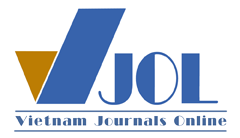Studying effect of temperature on to formation and red congo absorption ability of cupper oxide
DOI:
https://doi.org/10.51316/jca.2020.060Keywords:
Cu2O, hydrazine, absorption, congo redAbstract
Cuprous oxide nanoparticles (Cu2O) were prepared by a one-step reduction method at 65, 70 and 85oC temperature. The Cu2O nanoparticles were characterized by XRD, Raman, SEM and EDS techniques, respectively. The adsorption removal of red congo dye from aqueous solution by the as-prepared Cu2O nanoparticles was studied. Kinetics and isotherms studies suggested that the adsorption process followed pseudo-second-order and Freundlich models. The maximum adsorption capacity was estimated to be 82,6 mg/g, which was the highest reported value so far for red congo adsorption.
Downloads
References
Zhang YH, Jiu BB, Gong FL, Chen JL, Zhang HL., J Alloys Compd. 729 (2017) 563-570. doi:10.1016/j.jallcom.2017.09.237
Martínez-Ruiz A, Alonso-Nuñez G., Mater Res Bull. 43(6) (2008) 1492-1496. doi:10.1016/j.materresbull.2007.06.026
Hou TF, et al., Int J Hydrogen Energy 44(35) (2019) 19177-19192. doi:10.1016/j.ijhydene.2018.05.105
Hussain S, et al., Optik (Stuttg). 172 (2018) 72-78. doi:10.1016/j.ijleo.2018.07.026
Balık M, Bulut V, Erdogan IY., Int J Hydrogen Energy 44(34) (2019) 18744-18755. doi:10.1016/j.ijhydene.2018.08.159
Lee YJ, Kim S, Park SH, Park H, Huh YD., Mater Lett. 65(5) (2011) 818-820. doi:10.1016/j.matlet.2010.12.023
Li T, He M, Zeng W., J Alloys Compd 712 (2017) 50-58. doi:10.1016/j.jallcom.2017.04.057
Guo Q, Li Y, Zeng W., Phys E Low-Dimensional Syst Nanostructures 114 (2019). doi:10.1016/j.physe.2019.113564
Chen J, Perng D, Fang J., Sol Energy Mater Sol Cells. 95(8) (2011) 2471-2477. doi:10.1016/j.solmat.2011.04.034
Malerba C, et al., Sol Energy Mater Sol Cells. 95(10) (2011) 2848-2854. doi:10.1016/j.solmat.2011.05.047
Akerdi AG, Bahrami SH., Journal of Environmental Chemical Engineering 7(2019).
Singh J, Rawat M., J Bioelectron Nanotechnol 1 (1) (2016). doi:10.13188/2475-224x.1000003
Kumar M, Das RR, Samal M, Yun K., Mater Chem Phys. 218 (2018) 272-278. doi:10.1016/j.matchemphys.2018.07.048
Ghouri MI, Ahmed E., Ceram Int. 45(17) (2019 23196-23202. doi:10.1016/j.ceramint.2019.08.015
Kumar S, et al., Appl Catal B Environ. 189 (2016) 226-232. doi:10.1016/j.apcatb.2016.02.038
Kumar M, Das RR, Samal M, Yun K., Mater Chem Phys. 218 (2018) 272-278. doi:10.1016/j.matchemphys.2018.07.048
Xue R, Fan X, Liu Y, Li P, Liu Q, Liu F., Chem Phys Lett. 730 (2019) 45-53. doi:10.1016/j.cplett.2019.05.036
Qin H, et al., Mater Chem Phys 232 (2019) 240-245. doi:10.1016/j.matchemphys.2019.04.081
Tang H, Liu X, Xiao M, Huang Z, Tan X., J Environ Chem Eng 5(5) (2017) 4447-4453. doi:10.1016/j.jece.2017.08.034
Aguilar MS, Rosas G., Environ Nanotechnology, Monit Manag 11 (2019). doi:10.1016/j.enmm.2018.100195
Do DD. Adsorption Analysis: Equilibria and Kinetics. 2 (1998). doi:10.1142/p111
Dhritiman Gupta, S. R. Meher, Navas Illyaskutty, Zachariah C. Alex, Journal of Alloys and Compounds 743 (2018) 737-745. https://doi.org/10.1016/j.jallcom.2018.01.181
Mao SF, Ding ZJ., J.Phys. Condens. Matter 24 (2012) 1-9. doi:10.1088/0953-8984/24/17/175002
Liu X, et al., Appl Surf Sci. 405 (2017) 359-371. doi:10.1016/j.apsusc.2017.02.025














